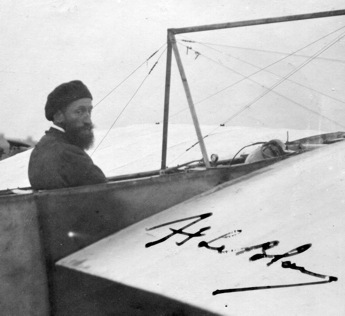1874-1910 (French Pilot's Licence No. 38)



Hubert Le Blon was born in Boulogne-Billancourt, a suburb
west of Paris, on March 21st, 1874. He had engineering education and
between 1898 and 1900 built "voiturettes" together with his
brother under the name "Le Blon Frères", also sold as
"Lynx" in Britain. Le Blon developed a successful carburettor
for alcohol engines which was used in lightweight racing cars and
thereby came in contact with Léon Serpollet, who built steam-powered
cars.
In 1902 - 1907 Le Blon participated in many automobile races for
Gardner-Serpollet, Hotchkiss, Panhard, Isotta-Fraschini, Thomas and De
Luca-Daimler, winning the hill climbs of Côte de Gaillon in 1902 and
Namur-Citadelles in 1904. His wife Motann Le Blon often accompanied him
as a riding mechanic, but she also drove racing cars herself and
actually beat her husband in a 500-metre competition at Deauville in
1903. His last automobile race was the July 1907 French Grand Prix,
where he was severly injured and had to go through several months of
convalescence.
In 1908, after recovering, he turned to aviation and became a pupil of
Léon Delagrange, making his first flight in a Blériot XI on September
18th, 1909. His first competitive event was the 1909 Spa meeting less
than two weeks later, where he made the longest non-stop flight. This
was followed by the Doncaster meeting, where he gained many fans by his
fearless flying in windy conditions and by a miraculous crash where he
managed to avoid coming down in the middle of a spectator area.
In early 1910 the Humber Ltd of Coventry displayed a monoplane designed
by Le Blon at the London Olympia aviation exhibition. It was quite an
inventive plane, with a slim tubular monocoque fuselage on which the
pilot sat astride, but the development apparently led nowhere.
Le Blon competed on his own in the February 1910 Heliopolis meeting,
having taken over Delagrange's machines after his death five weeks
earlier. He made the third longest flight of the meeting and set an
official 5-kilometre speed record.
From March 27th, 1910 Le Blon made a series of flights at the Ondarreta
beach in San Sebastián in northern Spain. On March 29th he ditched in
the water, but was saved. He was not as lucky on April 2nd. After a
short flight over the sea his machine developed engine problems and as
he turned back towards the beach a rigging wire broke and a wing
collapsed. The plane crashed inverted from relatively low altitude,
trapping the pilot below the surface. It happened close to the shore,
but before help could arrive Le Blon was dead. He had also been injured
by the crash, but it was declared that the cause of death was drowning.
He was the fifth pilot to lose his life in an airplane accident.
Le Blon qualified for French pilot's licence (No. 52) on March 8th,
1910.
Hubert Le Blon participated in the following air race
meetings:
- Spa 1909
- Doncaster 1909
- Heliopolis 1910
